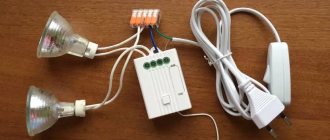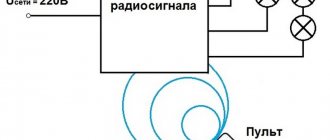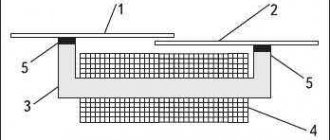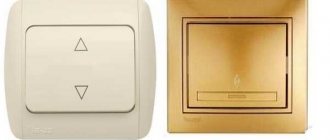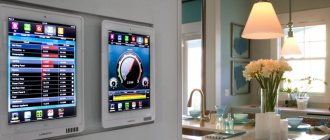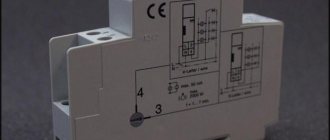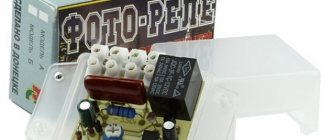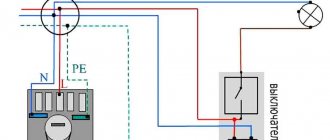Wireless light switch is a multifunctional accessory for controlling home lighting. It turns the lighting on/off by sending a signal “over the air” to a receiver or relay. To install such a device, you do not need to lay many meters of wiring and ditch walls, and it can be placed in any convenient place (within the reach of actuators).
Design and principle of operation
The wireless switch structurally consists of two elements:
- signal transmitter;
- receiver.
Together they provide remote control of the lighting system.
The connection diagram for the wireless switch is simple:
- the transmitter is installed in the selected location;
- the receiver with the relay is placed in the light source or next to it;
- Power is supplied to the input from the home electrical network, and a load is connected to the output.
How to connect the receiver to the transmitter is described in the attached instructions: usually just press the pairing key, but in the case of “smart” gadgets, sometimes you need to link them via the Internet and the smart home application.
Receiver
The receiving part is an over-the-air relay. When a command arrives at the receiver, the relay is activated and closes the contacts, turning on the light. Disconnection occurs on another corresponding command.
The board has two groups of contacts - input and output. The first is usually designated by the word Input, the second by Output. This hint is given to avoid incorrect joining. The board itself is no larger than a matchbox and is easily hidden in the body of a chandelier or lamp.
The relay is installed as close as possible to a lamp or other lighting device, but always within the “visibility” of the signal from the transmitter. At the same time, such gadgets are sometimes placed directly in the junction box, if technically possible.
Control is carried out from a remote control, computer, tablet or smartphone via a supported wireless communication protocol.
Transmitter
This device must be mobile, so most transmitters operate on autonomous power sources - batteries and rechargeable batteries, or have kinetic generators to convert the keystroke pulse into current.
An important parameter is coverage area. It depends on the technology used and the configuration of the room. Inexpensive models have a range of action of 20–50 meters, while advanced ones are capable of “piercing” a radius of up to 350 m. But they also cost significantly more, being intended for large houses and other premises with a large area.
There are models on sale designed for “smart homes” that can not only turn the lights on and off, but also change the level of illumination. To do this, they are equipped with a special regulator - a dimmer. It controls the supply of power to the lighting fixture, changing the brightness by reducing or increasing the power. Dimmers interact effectively with both modern LED lamps and classic incandescent lamps.
Recommended reading: Find out what a smart light switch is and what are the benefits of using it.
Briefly about the main thing
You can control the lighting in your home and surrounding area from a distance. For this, several options are used - common for several lamps, remote control, PC or smartphone, and automatic using sensors and a timer. The use of remote control solves many important problems - improving comfort, saving energy, stabilizing lighting characteristics, combining lighting devices, automating control, enhancing security, improving security, and the ability to combine with other home systems.
Main advantages:
- Availability of installation.
- Smooth adjustment of parameters.
- Specified operating mode.
- Optimization of electricity consumption.
- Extending the service life of lamps.
- Ability to turn on and off multiple devices.
- Strengthening control over electrical equipment.
Disadvantages are the need for financial costs and the possibility of interference with work. At the same time, several options are available for controlling the lighting in the house - using a remote control, a radio wave switch with a light control unit and motion sensors. Each method has its own characteristics and scope of application.
What types of wireless switches are there?
The operating principle of remote lighting controllers is similar, and they are structurally similar in many ways. But there are also differences. There are varieties based on the type of control:
- wireless touch light switch;
- button;
- switch with remote control;
- mixed type.
Another classification is based on the number of paired devices. Budget models support 1–2 receivers, advanced ones “can” control 7–8 devices or more.
Switches are also distinguished by the presence or absence of a dimmer.
An important difference is the built-in functionality. Basically, this type of gadget simply turns the light on and off at the owner’s command, and models with a dimmer control the intensity. But expensive options come with features such as:
- delay timer. The device will not work immediately after pressing the button, but a little later;
- multi-channel controller. The device operates simultaneously via several communication channels (for example, individual radio frequencies), interacting with several executive components at once. The latter can be distributed among different rooms and floors;
- presence of a touch panel. This design solution avoids wear and tear on mechanical buttons. To activate, just touch the touch surface;
- Wi-Fi support. This is a very important function, thanks to which devices can be controlled from a smartphone, tablet, home PC, and even via the Internet if there is a gateway.
The set of functions directly affects the cost: the more features, the higher the price.
By type of control
Let's take a closer look at the classification of switches by control.
Mechanical
They are very similar to the usual wall ones. The control mechanism looks like regular keys or a button. By pressing it, the user initiates sending a signal to the relay. Switching to the “off” position instructs the device to send a shutdown command.
One light source is assigned to each key. A two- or three-key device is capable of controlling the corresponding number of sources, but it will cost slightly more.
Sensory
As already mentioned, these gadgets are controlled via a touch panel. To activate it, simply touch it.
With remote control
In this version, signals are sent from a special remote control. This subtype includes models controlled via Wi-Fi.
In the case of the remote control, the range of action is approximately 25 meters, if there are no thick walls or other obstacles in the room. If they are present, the radius narrows to 3–5 meters, and at a line of sight distance, on the contrary, it can increase to 50 m.
You can expand your coverage area by installing repeaters. This also applies to versions with Wi-Fi.
Outdoor automatic lighting control
Intelligent smart light technology is widely used for outdoor applications. Special sensors are installed that control the operation of street lamps and record changes in natural light. As soon as it gets dark, electrical devices automatically turn on.
The level of illumination depends on the time of day. The darker it is outside, the brighter the lamps will burn. You can “mute” them by changing the setting in the program. If there is no need to illuminate the area in the absence of people, it is enough to set the night mode. In this case, the sensors will react only when a person approaches the house.
Smart outdoor lighting
This is interesting! Thanks to the external control system, the effect of the presence of the owners in the house is created. This discourages intruders from entering private property.
Where to buy wireless switches
You can purchase wireless switches either in a specialized store or online in an online store. In the second case, the budget option for purchasing products on the Aliexpress website deserves special attention. For some switches there is an option for shipment from a warehouse in the Russian Federation; they can be received as quickly as possible; to do this, when ordering, select “Delivery from the Russian Federation”:
| Universal relay with a set of switches for wireless control | AXUS smart wall switch with Wi-Fi | Smart Wall Switch with Wi-Fi |
| Switches with remote control EsooLi | Wireless touch switches SMATRUL | Wireless switch with receiver |
Controller in base
It does not have wide functionality, but is easy to install. You don't even need a screwdriver to install the controller! Instead of a lamp with an E27 socket, this device is screwed in, which in turn has a socket for an E27 lamp. There is an obvious dependence on the wall switch. Controllers are available with and without dimming. For example, let’s take devices from the “Cozy Home” series from - the cartridges are programmed to the desired keys of the remote control with a special button, the range is 30 meters, the frequency is 433.92 MHz.
The “cozy home” line also includes plug-sockets that work in a similar way.
Where are they used?
Wireless switches are used wherever it is necessary to install a new or move an old switching device, but due to some circumstances it is impossible to get by with classic wired options.
In difficult situations, it is possible to install such a gadget not only on the wall, but also, for example, inside a closet shelf, on a mirror, and so on. This does not affect functionality - the device will continue to function normally. This will help save space and not worry about the aesthetic side if, for example, the purchased accessory turns out to not match the overall style of the room. You can simply hide it.
A remote light switch will also come in handy in case of errors with the wiring. Now you don’t have to re-arrange everything, just place the “over-the-air” model in a convenient place, and the problem will be solved.
This class of accessories is gaining popularity in the field of wooden construction. Wiring in a wooden house requires special fire safety measures, and wireless devices help reduce the number of potentially dangerous cables. In addition, in the case of open wiring, the latter is more vulnerable to damage, and wireless-type modules largely eliminate the likelihood of breaks, short circuits and other troubles. Although the remaining wired communications still require protection measures.
An “air” switch will be a real salvation in houses with many rooms or rooms divided into locations with separate types of lighting. You don’t need to install many separate devices—it’s enough to get by with one or two (for example, multi-key devices) and associate them with the necessary lighting fixtures, and then activate the necessary segments as needed.
Another use case for wireless light switches is in renovated spaces. When the renovation is completed and the final coating has been applied to the walls (be it laminate, wallpaper, paint or something else), it can be difficult to add any functional electrical wiring components to the decor. Including the switch - this requires dismantling the finishing, gating and other manipulations. A wireless switch solves this problem - you just need to place it in the right place with a minimum of time and effort, and without harming the new interior.
The same applies to premises with historical value, where large-scale interventions and changes to the situation cannot be carried out. Remote switches can easily be “disguised” into furniture and objects and provide comfortable control of the lighting level.
You cannot do without a modern lighting control system in large commercial premises, conference rooms and other places with large areas. It will make it possible to turn on the lights throughout the entire territory from one device, including while outside the building. The same system allows you to track your status, and the most advanced models even have the function of counting the kilowatts spent.
Smart socket with timer
A smart timer is a compact device that looks like a regular adapter. It needs to be integrated into the outlet, and then connect the household appliance there.
Features of socket timers:
- Power off after a specified period of time.
- Turning on the power at a specific time.
- Remote control over the operation of electrical appliances.
- Calculation of energy consumption.
A socket with a timer is very useful in everyday life. Having installed even the simplest device, you no longer have to worry whether the iron is turned off. Even if you forget about it, the smart system will react and block the power supply.
Using a socket with a timer, you can set the appliances to operate at a certain time. For example, program the coffee maker to turn on in the morning.
Timers on the socket will also come in handy during the holidays. Before the New Year, garlands and other lighting decor appear in homes. Many people forget to turn off their devices before going to bed, which can result in the devices burning out. Smart plugs can help you avoid this fate.
And the main advantage of the system is the ability to compare energy consumption indicators for different devices. It is enough to plug one device into the outlet first and record the measurements. Then you can do similar actions with another device. As a result, you will know which household appliances consume more energy and increase your electricity bills.
Smart socket with timer
Advantages and disadvantages
A remote controlled light switch is convenient, modern and practical. Advantages of this class of devices:
- easy installation. There is no need to dismantle the trim, do gating and pull additional wiring;
- centralized control over all light sources within reach from one switch, remote control or computer/phone/tablet;
- possibility of remote control, including from outside the room/building;
- high operational safety. All devices consume minimal current and are not dangerous even in case of incorrect use or breakdown;
- for the most multifunctional models - additional features: work according to a schedule and triggers, remote access, integration into a “smart home”.
But there are also disadvantages:
- Battery-powered gadgets need to be replaced regularly;
- If a Wi-Fi connection scheme is used, the channel is very sensitive to the quality of the connection. A weak signal or a high level of interference (for example, a clogged airwave with many Wi-Fi gadgets) can seriously hamper the operation of the device and cause numerous “glitches”, even complete inoperability.
We begin modernization
When considering the existing options, I leaned towards the schedule control option. It's no secret that there are publicly available schedules for turning off outdoor lighting. For Moscow and St. Petersburg, for example - MOSSVET and LENSVET. With this information, it’s easy to write a script that monitors time and controls lighting according to a schedule. Moreover, there is a Linux machine on the Ethernet network to which the PLC is connected.
In order for such a script to control remote I/O modules, it was necessary to re-create the project for the PLC. In essence, the PLC began to act as a gateway, which gave us the opportunity to control lighting using the open Modbus TCP protocol.
To work with Modbus we will use the modpoll utility. Let's download and unpack it on our Linux machine:
$ wget https://www.modbusdriver.com/downloads/modpoll.tgz $ tar xzf modpoll.tgz $ sudo cp modpoll/linux_x86-64/modpoll /usr/local/bin/
Now we will control the lighting as follows:
#Enable lighting $ modpoll -m tcp -r 2 -t 0 -a 1 -p 502 192.168.0.227 1 1 1 1 1 1 1 1 #Disable lighting $ modpoll -m tcp -r 2 -t 0 -a 1 -p 502 192.168.0.227 0 0 0 0 0 0 0 0
All that's left to do is call these commands according to a predetermined schedule. As mentioned above, such graphs are available and we can use them. But there was a desire to find a more universal approach, so let's remember such a phenomenon as “twilight”.
Subtleties of choice
When choosing a device, you should consider some important characteristics. Among them:
- the type of light bulbs that the device can control;
- dimensions;
- appearance of the device (case color, material, shape, for mechanical ones - number of keys/buttons);
- operating voltage;
- wireless technology;
- number of interface channels;
- signal coverage radius, ability to work through repeaters;
- maximum operating load;
- rated current;
- operating frequencies;
- presence/absence of encryption;
- way of eating;
- type of control (buttons, remote control, sensor, all of the above);
- possibility of remote control from a smartphone, tablet or personal computer;
- if integration into a “smart home” is planned – the presence of such a function and supported intelligent systems;
- battery life declared by the developer;
- fastening method;
- price.
As you can see, it is advisable to start selecting a wireless switch already at the design stage of the room in order to buy the most suitable sample for specific conditions. But if a gadget is bought for a ready-made and finished house, room, or commercial property, the first place comes to cost-effectiveness, compactness, versatility and inconspicuousness (or a design that matches the interiors).
In addition, it is important to have a factory warranty and manufacturer service centers. They will make it easier to repair or replace a faulty device.
Some popular switches
The range of devices under consideration is quite large, and some of them are in deserved demand due to the combination of quality, price and functionality. Let's consider several such models.
Feron TM-75
This is a simple and reliable two-channel 220 volt light switch. It interacts correctly with spot “smart light bulbs”, lamps, floor lamps, sconces, chandeliers and other light sources. The set includes a remote control, holder and battery.
The range of the device is up to 30 meters.
Aqara WXKLG02LM
The Chinese remote-controlled circuit breaker from Aqara can be used both in standalone mode and in conjunction with the Xiaomi Mi Home smart home. The module has two buttons and is controlled via Wi-Fi and Bluetooth; it also has the ability to work via the Zigbee protocol.
In general, control is carried out using keys, but the gadget is also supported by the Mi Home application. It works in a Wi-FI coverage area; among the shortcomings, we note the need for the Internet to implement full functionality.
Feron TM-2334
Another wireless remote model from the manufacturer Feron. There is a two-channel radio module with a control panel. The device is capable of controlling spotlights, floor lamps, sconces and chandeliers. For the latter, any number of lamps is supported, but lamps are divided into groups according to the principle:
- three lamps - 1+2, the first is lit with one key, the second and third - with another;
- four - 2+2 or 3+1;
- five - 2+3, 1+4. Other options are possible - it depends on the firmware.
The stable signal radius is up to 30 meters, there is a delay function.
Hite PRO SN-R1
This wireless wall switch is a Russian development, characterized by a range of up to 25 meters, a three-year factory warranty and a claimed 15 years of flawless operation. Another important advantage is up to 7 years on one battery. The channel frequency is 865 MHz.
Such capabilities allow you to use the switch in an apartment and at home, in a cottage, in suburban areas, and so on. But this is compensated by the cost of the device - if usually the price of switches does not exceed 1000 rubles, then for this sample they are asking about 1700.
Inted 220V
Chinese two-key switch designed to control two lamps or two lighting groups. The device is mounted on the supplied mounting hardware and supports a load of up to 1000 W; the main unit runs on one battery.
The gadget is considered reliable, despite only a year of warranty.
ZDK Z-Light 0287
Another two-key sample. It is interesting due to the absence of a battery: the design includes a microgenerator, which is sufficient to generate a signal at a frequency of 433 MHz. Another advantage is the possibility of implementation in smart home solutions from ZDK. For full operation, the Internet is required; after connection, control of the device from anywhere in the world through the application becomes available.
Among the disadvantages, we highlight the need to purchase a separate receiving radio module and the inflated cost.
Armalight AS-6M
This is a simple wireless pass-through switch with one key. Like the previous one, it does not require a battery: the built-in kinetic module converts the pressing energy into a current sufficient to send a signal. Distinctive features:
- operation at 433 MHz;
- declared resistance to high humidity and even the ability to function under water;
- device resource - 200,000 on-off cycles, or approximately 15 years without breakdowns;
- range of action - up to 70 meters.
But they ask for quite a lot for this - more than two thousand rubles.
Gritt Elegance
This radio switch comes complete with a two-line remote module. The control unit is supplied in one-, two- and three-key versions, which ensures the choice of the option required for a specific configuration.
The device is also battery-free and equipped with a kinetic microgenerator. Pressure force is converted into current to create a signal in the 433 MHz range. Resource - 200,000 clicks/15 years.
The switch is two-channel, one radio module supports two lighting lines. But its cost is high, more than 3,500 rubles.
Design features of the modules:
The use of single-sided surface mounting allows the modules to be quite compact and easy to manufacture. The open-frame version (in a heat-shrinkable tube) significantly reduces the cost.
The brains of the modules are the inexpensive STM32F0 microcontroller, with a large margin of capabilities. The consumption of the microcontroller and the RS-485 transceiver is quite low, which allows the use of linear regulators to power them. Operating voltage range of modules 8-24V
. This wide range of operating voltages is due to the lack of a uniform standard in home automation: different systems use both 12V and 24V. In addition, we wanted to ensure stable operation even when the voltage on the cables sags.
In order for the relay module to operate in a wide voltage range, the following trick was used: the relays have an operating voltage of 12 volts, but the MK measures the input voltage and controls the relay coil using PWM with a duty cycle of D=12V/Uin, i.e. The average current through the relay coil remains rated even at high input voltages. Also, after turning on the relay, the holding current is set to half the rated one - this reduces the heating of the relay and the overall consumption of the device by 4 times.
When using PWM there is a peculiarity: at low frequencies the relays act like a speaker. To prevent devices from squeaking, the PWM frequency is set outside the audio range and is 24 kHz.
Power transistors for the WB-RGB LED dimmer are IRF8736 (Vmax=30V, channel resistance only ~5mOhm). The 74HC125 buffer increases the control voltage from 3.3V on the MCU to 5V on the gates. This allows such a small scarf to remain cold even with a current of 5A per channel.
To regulate the brightness of LED strips, the LED dimmer uses PWM. In the vast majority of competing products, the PWM frequency is in the region of 100-200 Hz, and in particularly bad cases this leads to noticeable flickering of the lighting. In our device, PWM operates at a higher frequency. As in the case of the relay, the frequency is brought to the edge of the audio range, but here this is done to avoid the squeaking of some not very high-quality power supplies for LED strips.
Obviously, the function of saving the module state when the power is turned off is highly desirable. The STM32F0 has an unpleasant feature in this regard: it does not have a built-in EEPROM, only flash memory with a very limited rewriting resource. Writing to flash memory every time a new value is received is too wasteful, so the state is stored in RAM and reset to flash only when the power is lost. The moment of switching off is monitored by the voltage drop below a certain threshold.
Simply saving the state when turning off is not enough, because the number of rewrites of one cell is limited to a thousand cycles. Therefore, the next level of optimization is to use all free memory, i.e. write values evenly using different cells.
The operation of writing a bit (i.e. setting a value to one) to flash memory is fast, but erasing is only done page by page, takes a long time and requires a lot of energy. If there are no free cells left, you need to erase the entire page before writing a new value. To do this, you would have to install a huge capacitor for “backup power” when turned off.
We use the following technique: when we turn on the MK, we first check whether there is free space for recording in the flash; if there is none, then we free up space for future recording by erasing pages.
